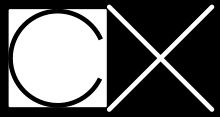
Welcome to the PCW CX Audio Decoder help page.
I sincerely hope that the information herein will help you to make better use of
PCW CX Audio Decoder.
These help pages are valid for version 0.8.0 and later
PCW CX Audio Decoder is a piece of software, written for PCs running the Windows operating system.
This software allows you to decode or process audio recordings, specifically those on vinyl discs or on LaserDisc, that have been recorded and produced while using the compressor part of the CX audio compander system.
The CX system (*) has been designed in the late 1970s by CBS Laboratories. It comes in two flavors, namely CX 20, which has been used on vinyl discs, and CX 15, which has been used for the audio signals on LaserDisc. You can identify such recordings by the following label:

PCW CX Audio Decoder can be used for both of these versions. Especially for decoding the audio signals from vinyl records, as only a few record players with built-in CX decoders have been produced. All LaserDisc players manufactured since 1981 had CX noise reduction capability built in as a standard feature. So, when playing a LaserDisc on such a player, the built-in CX decoder should be used. There is no need to apply the decoding process a second time. PCW CX Audio Decoder can only help, when a LaserDisc is played on an older LaserDisc player without built-in CX decoder.
You can read more on the CX system on Wikipedia.
PCW CX Audio Decoder should not be used for decoding audio signals that have been processed with any other of the various companding systems, and it can also not be used for removing noise from an unprocessed recording.
This software has been designed with appropriate care, it should not exhibit any harmful side effects. Nevertheless, you use it at your own risk. If you do not agree, then please do not use it.
Go to top.You can download the most recent version of this software in a zipped archive from here. Save the archive file on your computer and remember the location.
Go to top.When you download and install PCW CX Audio Decoder, you are granted a personal, non-exclusive and unlimited license, completely free of charge.
Go to top.Double-click on the saved archive file. The archive should open and display a single file:
(The version information "x.x.x" reflects the current version.)
Start the installation by double-clicking on the executable file.
A welcome window will open. Click "Next" and the license agreement will be displayed.
If you agree to the terms of the license agreement then you should check the "I agree ..." box and
click on the "Next" button. Then installation will start.
The installation process is simple, there are no new DLLs, no additions to the registry file, and no changes to your
operating system. An entry will be added to the startup menu and an icon will be placed on your desktop.
The installation can be reversed without a trace left.
I'm afraid, there is no other way than you just go on and trust me. Switch off your Antivirus system while you install PCW CX Audio Decoder. And in case your Windows OS is complaining as well, there should be a button like "do it anyway" or "I know what I'm doing". Try this.
There is a chance to increase trust in the installer software package: On the page you used to download the installer software, I have published the SHA256 checksum for exactly this software package. After downloading the file, you can yourself calculate the SHA256 checksum for that specific file you now have on your PC. And when those two checksums are identical, you can be sure that you have the original file and nobody has tampered with it.
To calculate the SHA256 checksum you need another piece of software, e.g. Hashing for Windows. And this is easy, free and open source. You can get it from here: Hashing App.
Go to top.
On certain installations of Windows 10 the automatic placement of an icon on the desktop may be prohibited.
In this case you have to locate the program "PCW-CXAudioDecoder.exe" on your computer. With a right-click you
open the context menu and then chose "shortcut".
In Windows 10 you can as well go to the Start Menu List and locate the entry for PCW CX Audio Decoder.
By left-clicking on the icon you can drag it onto your desktop.
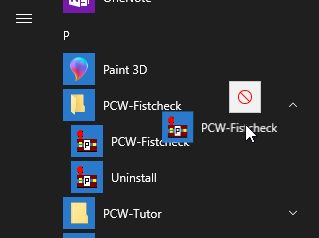
You either double-click on the PCW-AudioDecoder shortcut icon on your desktop or you go to "Start" - "Programs" and locate the "PCW-CX-AudioDecoder" entry. Double-click on "PCW-CXAudioDecoder", the program will start.
Go to top.
It is very easy to actually use this piece of software. But before you can use it, you have to perform a few steps
to transfer your analog recordings on vinyl or LaserDisc into a digital version on your computer.
Please read on.
First of all, you need a record player for your vinyl discs or a LaserDisc player for your LaserDiscs. For your record player you need a proper pre-amplifier that is often incorporated into a standard Hi-Fi amplifier. Connect your record player or your LaserDisc player to such an Hi-Fi amplifier and locate a pair of output sockets that are usually meant as output going to a tape recorder. Connect these to the audio input of your PC.
In order to do the actual transfer from vinyl or LaserDisc to a digital file on the PC, you have to indentify or get a proper audio interface to the PC. Please read on for further information. If that's nothing new for you, then continue here.
Go to top.Most table-top PCs do have a "line" audio input. This is the right place to connect to the audio output of your tape playback machine.
But many laptop PCs only have a "Mic" input. In most cases this input will not give good results. Luckily, there are small and cheap alternatives: audio interface boxes with USB connectors, see next picture.
Just plug this interface into an empty USB socket and connect the output of your tape playback machine to the "L" and "R" "Input" (cinch) sockets of the adapter.
You have to make sure that the interface is able to digitize audio signals with one of the higher sampling frequencies like 96 kHz. More on that further on.
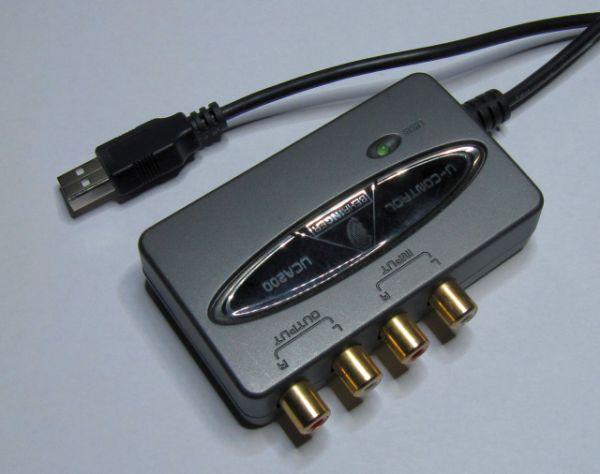
Next you need a piece of software that lets you actually record the analog audio signals in digital form and store them as a ".WAV"-File onto your PC.
A powerful and free piece of software suitable for this task is "Audacity", that you can get from here:
https://www.audacityteam.org
Download and install, then start the program.
As a first step you should identify your audio input device. There is a drop-down menu, and in this case we use the
device with something like "USB" in the name.
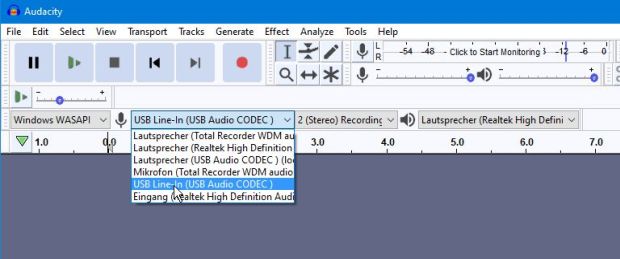
Next you should adjust the quality preferences. Select Edit/Preferences/Quality and adjust the Default Sample Rate to 96000 Hz and the Default Sample Format to 24 bit. These values are not mandatory but help preserve the over-all quality.
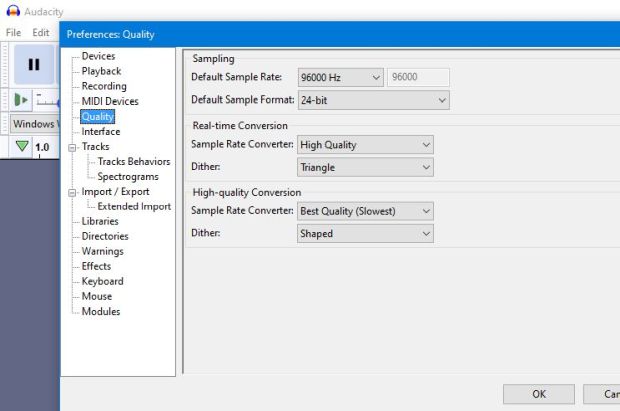
Now go to the top row where it says "click to start monitoring"
When everything is OK, you should now see some reaction on any input signal you have connected. In this example
there was a 400 Hz signal with level 10 dB below digital maximum.
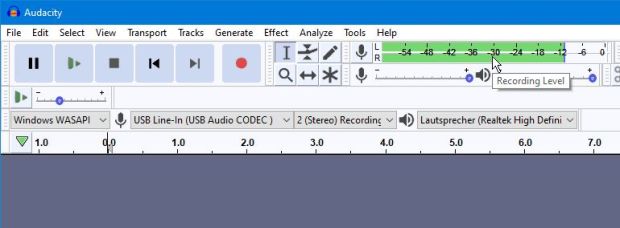
OK, hit the red button - and recording should start.
Then, after a few seconds, hit the "stop" button, the one with the black square.
With a constant signal like above you will probably get something like this:
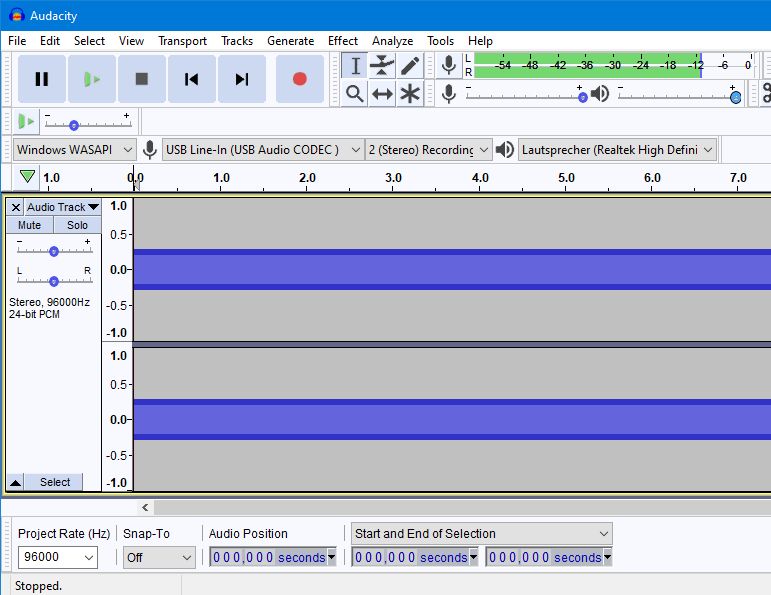
Finally you need to save the digital recording to your hard disc storage system.
Select File/Export/Export as WAV
Now you have to decide where to store the recording and what name it should have. Don't forget to select
the correct format under "Save as type":
From the drop-down menu select "WAV (Microsoft) signed 24-bit PCM".

That's it - you have successfully created a digital audio file from the analog audio input.
OK, you have a digital audio file in .WAV format that contains an audio signal. And this audio signal has come from a vinyl disc or LaserDisc, either marked with a CX Label. Now you want to process and decode it, digitally.
OK, simply launch PCW CX Audio Decoder. You will see this work area:
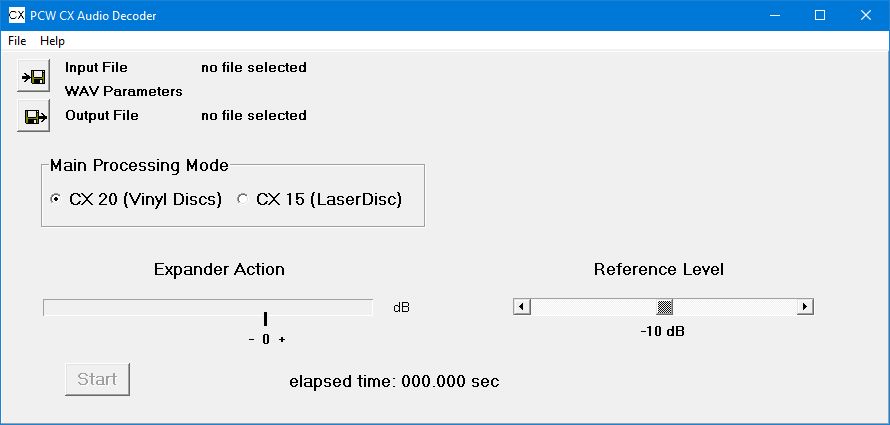
You'll notice that you have the choice to select one of two different Main Processing Modes, and that the CX 20 Mode is preselected when you start for the first time.
Now, click the top left icon to find and select the name of your input .WAV file. Then click the output file icon below. The name of the output file is preset with the name of your input file with "_dec" appended. But you can select any suitable directory or name for the output file.
In case there is already a file with the same name, then a window will pop up, asking you if it is OK to overwrite.
Let's take one of the files I happen to have on my PC. The work area now looks like this:
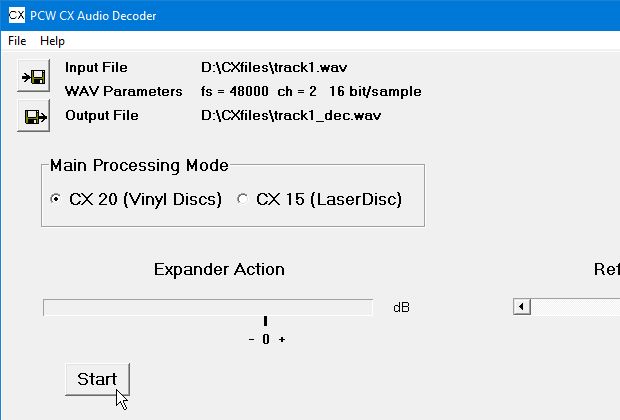
You can see that the directories and file names of the selected input and output files are indicated. And further on, some information on the digital audio files is given: sampling frequency fs, number of audio channels ch, and number of bits per audio sample.
Please note that the number of audio channels must be ch = 2. When you select an input file with a different number, you will get an error message and no processing will be done.
Now push the Start button and processing will start, and this processing will be quite fast on a typical PC.
While the program is working, the Start button is turned into an Abort button. Here you can immediately stop processing if you need to.
Go to top.In order to get the best possible quality from a vinyl disc produced with the CX system, you have to make sure that a certain playback level is established between the output of the record player (probably after the pre-amplifier) and a hardware CX-decoder or this CX decoder software. CBS Laboratories had given two methods to follow: a precise version and an approximate version.
For this you need a special vinyl disc with test recordings. Such records are extremely scarce today. But when you are lucky to get one, then try to identify a recording with a tone of 1 kHz frequency and a fixed recording velocity. Typically you would find a recording with separate signals in the left and right channel, each cut with a recording velocity of 3.5 centimeter/second RMS or 5 cm/sec PEAK. When you have a recording cut with different velocity, then you have to scale your test accordingly.
Now, play this part of the test record and transfer the signal into a WAV-file on your computer, as described above. Try to end up with a digital signal with a level of about -10 dB below peak, as seen in the screenshot below. And, by all means, note all level settings you have made on your record player, pre-amplifier, and input to the PC. You will need exactly these settings for any further playback.

Now load this file as input to PCW CX Audio Decoder as described below. For each of the two separate recordings on left and right channel, you should get an indication of 0 dB on the Expander Action display.

In case you get a lower indication, say of -2 dB, like below,

then please adjust the Reference Level slider by the same amount to a lower level, like shown in the next picture. And if you get a higher indication, adjust the slider in the opposite direction.

This should set your reference level. And again, please note all level settings and keep them for all further work.
In case you cannot get your hands at a vinyl test record with precise velocity signals, you are not lost. Just load a file prepared from a vinyl disc and run PCW CX Audio Decoder. Watch the display and adjust the Reference Level slider so that peaks in the Expander Action display reach or slightly exceed the 0 dB mark.
Then double-check the resulting output signal for any untypical level changes.
As stated before, all LaserDisc players manufactured since 1981 should have the CX noise reduction capability built in as a standard feature. There is no need to apply the CX decoding process a second time. But in case you want to play a LaserDisc on a player without CX decoder, you can use this PCW CX Audio Decoder software to do the CX decoding. You also need to set a proper reference level, and all you can do is apply the aforementioned approximate way of setting a reference level for vinyl records.
Go to top.
If you encounter a problem not covered on this help page, then please send an
EMail with a clear description of your problem.
Please allow for a reasonable response time.
Any feedback is highly appreciated. Please send an EMail and describe what is missing or what you have found out. And if just in case you find this software helpful and supportive for your work, why not send a short message?
Go to top.If you want to install a newer version of PCW CX Audio Decoder, then you do not have to uninstall any older version. Just install the new version over the older version.
Go to top.That's easy: select "Start" - "Programs" from your task panel, then identify the entry for PCW CX Audio Decoder. Within this folder you will find a shortcut with the name Uninstall. Double-click and follow any instructions. Voilá, PCW CX Audio Decoder is removed from your system, very probably without a trace.
Go to top.(*) Trademarks are property of their respective owners.